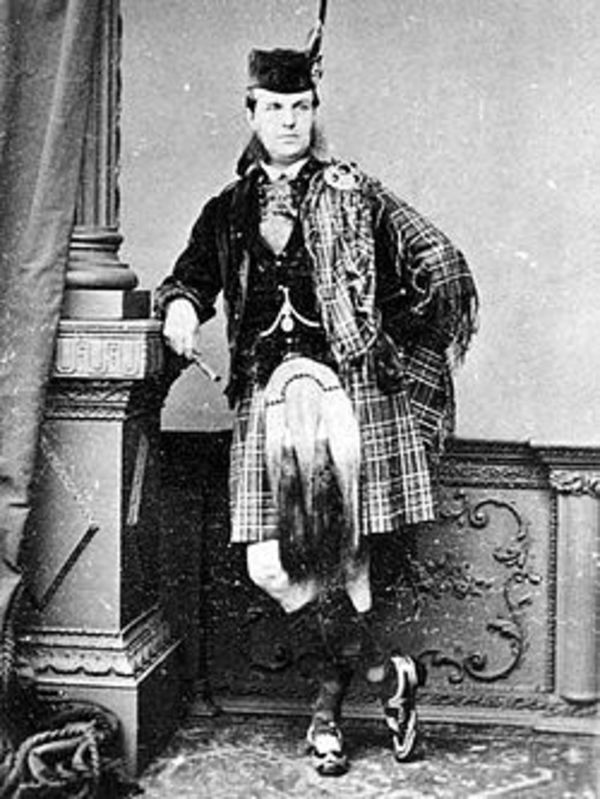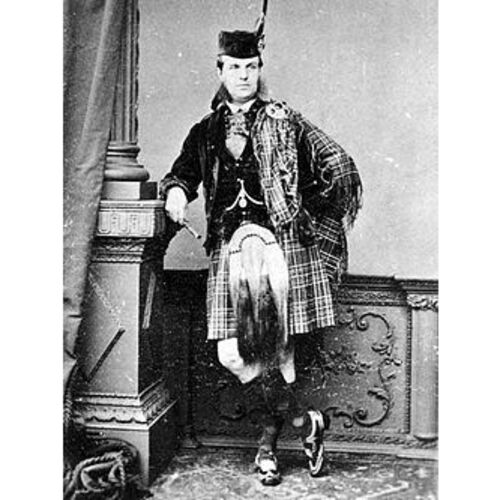
Source: Courtesy of Wikimedia Commons
GORDON, Lord GORDON (alias Hon. Mr Herbert Hamilton, Lord Glencairn, George Gordon, George Herbert Gordon, John Herbert Charles Gordon), adventurer and swindler; b. 184?; d. 1 Aug. 1874, Headingley, Man.
Gordon’s career is first documented in 1868 when, using the name of Glencairn, he leased a shooting estate in Scotland after convincing London solicitors and Edinburgh jewellers that he would fall heir to the title and fortune of Lord Glencairn on 25 March 1870. He vanished from the British Isles shortly before that date.
In 1871 he appeared in Minneapolis, Minnesota, with the name Gordon. There he convinced the Northern Pacific Railroad that he was about to buy a vast acreage. He moved to New York in January 1872 and rapidly, but briefly, convinced the notorious financier Jay Gould that he held 60,000 shares of Erie Railway stock. Gould began court proceedings against Gordon when the deception was revealed, but his lordship fled to Canada leaving his bondsmen to pay $37,000 bail.
As Mr Gordon Gordon he arrived at Fort Garry (Winnipeg) in October 1872, posing as a British gentleman in search of sport. In Manitoba he lived quietly, enjoying frequent shooting expeditions, until 2 July 1873. On that evening he was seized by a party of Minnesotans, acting as agents of one of the bondsmen for his bail. The kidnappers attempted to abduct him to the United States, but were arrested the next day at Pembina, 100 yards north of the international border, on the ground that they had no legal authority on Canadian soil. They were returned to Fort Garry where stormy legal proceedings ensued. Throughout the remainder of the summer Manitoban, Canadian, Minnesotan, United States, and British officials angrily contested the legality of the abductions, arrests, and court proceedings within their respective authorities. By September 1873 the Manitoba courts had restored international calm but Gordon’s American accomplishments had been fully exposed.
On 1 Aug. 1874 his lordship’s British past also caught up with him. At the home of Mrs Abigail Corbett, where Gordon was boarding, he was arrested under a warrant issued at Toronto on the instance of an Edinburgh jeweller to whom he was in debt. Apparently deciding that the best of his days were now over, Lord Gordon Gordon shot himself through the head and died immediately, carrying with him to a Manitoba grave the truth of his origin and identity.
PAM, Alexander Morris, Ketcheson collection, correspondence, telegram book; Alexander Morris, Lieutenant Governor’s collection, Lord Gordon Gordon papers. Manitoba Free Press (Winnipeg), 12, 19, 26 July, 2, 9 Aug., 20 Sept., 22 Nov. 1873; 8, 15 Aug. 1874. W. W. Folwell, A history of Minnesota (4v., Minnesota Historical Society pub., ed. S. J. Buck, St Paul, 1921), III, 362–88. J. L. Johnston, “Lord Gordon Gordon,” HSSM Papers, 3rd ser., no.7 (1952), 7–20.
Cite This Article
John A. Bovey, “GORDON, Lord GORDON (Hon. Mr Herbert Hamilton, Lord Glencairn, George Gordon, George Herbert Gordon, John Herbert Charles Gordon),” in Dictionary of Canadian Biography, vol. 10, University of Toronto/Université Laval, 2003–, accessed April 1, 2025, https://www.biographi.ca/en/bio/gordon_gordon_10E.html.
The citation above shows the format for footnotes and endnotes according to the Chicago manual of style (16th edition). Information to be used in other citation formats:
| Permalink: | https://www.biographi.ca/en/bio/gordon_gordon_10E.html |
| Author of Article: | John A. Bovey |
| Title of Article: | GORDON, Lord GORDON (Hon. Mr Herbert Hamilton, Lord Glencairn, George Gordon, George Herbert Gordon, John Herbert Charles Gordon) |
| Publication Name: | Dictionary of Canadian Biography, vol. 10 |
| Publisher: | University of Toronto/Université Laval |
| Year of revision: | 1972 |
| Access Date: | April 1, 2025 |



